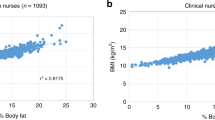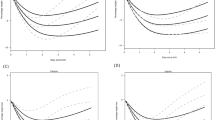Abstract
Background:
Classification of infants into low birth weight (LBW, <2500 g) or very low birth weight (VLBW, <2000 g) categories is a crucial step in targeting interventions to high-risk infants.
Objective:
To compare the validity of chest circumference and foot length as surrogate anthropometric measures for the identification of LBW and VLBW infants.
Subjects and setting:
Newborn infants (n=1640) born between March and June 2004 in 30 Village Development Committees of Sarlahi district, Nepal.
Design:
Chest circumference, foot length and weight (SECA 727, precise to 2 g) of newborns were measured within 72 h after birth. The sensitivity, specificity and predictive values for a range of cutoff points of the anthropometric measures were estimated using the digital scale measurements as the gold standard.
Results:
Among LBW infants (469/1640, 28.6%), chest circumference measures <30.3 cm were 91% sensitive and 83% specific. Similar levels of sensitivity for foot length were achieved only with considerable loss of specificity (<45%). Foot length measurements <6.9 cm were 88% sensitive and 86% specific for the identification of VLBW infants.
Conclusion:
Chest circumference was superior to foot length in classification of infants into birth weight categories. For the identification of VLBW infants, foot length performed well, and may be preferable to chest circumference, as the former measure does not require removal of infant swaddling clothes. In the absence of more precise direct measures of birth weight, chest circumference is recommended over foot length for the identification of LBW infants.
Sponsorship:
The National Institute of Child Health and Human Development; the Saving Newborn Lives Initiative, Save the Children – US and the Office of Heath and Nutrition, United States Agency for International Development (see Acknowledgements).
This is a preview of subscription content, access via your institution
Access options
Subscribe to this journal
Receive 12 print issues and online access
$259.00 per year
only $21.58 per issue
Buy this article
- Purchase on Springer Link
- Instant access to full article PDF
Prices may be subject to local taxes which are calculated during checkout


Similar content being viewed by others
References
ACC/SCN (2000). Low Birthweight: Report of a Meeting in Dhaka, Bangladesh on 14–17 June 1999. In: Pojda J, Kelley L (eds). Nutrition Policy Paper No. 18. ACC/SCN in collaboration with ICDDR,B: Geneva.
Ahmed FU, Karim E, Bhuiyan SN (2000). Mid-arm circumference at birth as predictor of low birth weight and neonatal mortality. J Biosoc Sci 32, 487–493.
Arisoy AE, Sarman G (1995). Chest and mid-arm circumferences: identification of low birth weight newborns in Turkey. J Trop Pediatr 41, 34–37.
Bhargava SK, Ramji S, Kumar A, Mohan M, Marwah J, Sachdev HP (1985). Mid-arm and chest circumferences at birth as predictors of low birth weight and neonatal mortality in the community. BMJ 291, 1617–1619.
Bhutta ZA, Darmstadt GL, Hasan B, Haws R (2005). Community-based interventions for improving perinatal and neonatal health outcomes in developing countries: review of the evidence. Pediatrics 115, 519–617.
Christian P, Khatry SK, Katz J, Pradhan EK, LeClerq SC, Shrestha SR et al. (2003). Effects of alternative maternal micronutrient supplements on low birth weight in rural Nepal: double blind randomised community trial. BMJ 15, 571–576.
Daga SR, Daga AS, Patole S, Kadam S, Mukadam Y (1988). Foot length measurement from foot print for identifying a newborn at risk. J Trop Pediatr 34, 16–19.
Darmstadt GL, Badrawi N, Law PA, Alam A, Ahmed S, Husein MH et al. (2004). Topical therapy with sunflower seed oil prevents nosocomial infections and mortality in premature babies in Egypt: a randomized, controlled clinical trial. Pediatr Infect Dis J 23, 719–725.
Darmstadt GL, Bhutta ZA, Cousens S, Adam T, Walker N, de Bernis L (2005a). Evidence-based, cost-effective interventions: how many newborn babies can we save? Lancet 365, 977–988.
Darmstadt GL, Saha SK, Ahmed AS, Chowdhury MA, Law PA, Ahmed S et al. (2005b). Effect of topical treatment with skin barrier-enhancing emollients on nosocomial infections in preterm infants in Bangladesh: a randomised controlled trial. Lancet 365, 1039–1045.
Dhar B, Mowlah G, Nahar S, Islam N (2002). Birth-weight status of newborns and its relationship with other anthropometric parameters in a public maternity hospital in Dhaka, Bangladesh. J Health Popul Nutr 20, 36–41.
Gohil JR, Sosi M, Vani SN, Desai AB (1991). Footlength measurement in the neonate. Indian J Pediatr 58, 675–677.
Gupta V, Hatwal SK, Mathur S, Tripathi VN, Sharma SN, Saxena SC et al. (1996). Calf circumference as a predictor of low birth weight babies. Indian J Pediatr 33, 119–121.
Hanley JA, McNeil BJ (1982). The meaning and use of the area under a receiver operating characteristic (ROC) curve. Radiology 143, 29–36.
Hirve SS, Ganatra BR (1993). Foot tape measure for identification of low birth weight newborns. Indian J Pediatr 30, 25–29.
Hossain MM, Habib M, DuPont HL (1994). Association between birth weight and birth arm circumference of neonates in rural Egypt. Indian J Pediatr 61, 81–87.
Huque F, Hussain AM (1991). Detection of low birth-weight new born babies by anthropometric measurements in Bangladesh. Indian J Pediatr 58, 223–231.
James DK, Dryburgh EH, Chiswick ML (1979). Foot length – a new and potentially useful measurement in the neonate. Arch Dis Child 54, 226–230.
Kapoor SK, Kumar G, Anand K (1996). Use of mid-arm and chest circumferences to predict birth weight in rural north India. J Epidemiol Community Health 50, 683–686.
Lawn JE, Cousens S, Zupan J (2005). Four million neonatal deaths: Where? When? Why? Neonatal Survival Series Paper 1. Lancet 365, 891–900.
Macdonald PD, Ross SR, Grant L, Young D (2003). Neonatal weight loss in breast and formula fed infants. Arch Dis Child Fetal Neonatal Ed 88, F472–F476.
Mathur A, Tak SK, Kothari P (1984). ‘Foot length’ – a newer approach in neonatal anthropometry. J Trop Pediatr 30, 333–336.
Mullany LC, Darmstadt GL, Coffey P, Khatry SK, LeClerq SC, Tielsch JM (2006a). A low-cost, color-coded, hand-held spring scale accurately categorizes birth weight in low-resource settings. Arch Dis Child 91, 410–413.
Mullany LC, Darmstadt GL, Khatry SK, Katz J, LeClerq SC, Shrestha SR et al. (2006b). Topical applications of chlorhexidine to the umbilical cord for prevention of omphalitis and neonatal mortality in Southern Nepal: a community-based, cluster-randomized trial. Lancet 367, 910–918.
Naik DB, Kulkarni AP, Aswar NR (2003). Birth weight and anthropometry of newborns. Indian J Pediatr 70, 145–146.
Ngowi JA, Redding-Lallinger R, Hirji KF (1993). An assessment of the use of anthropometric measures for predicting low birth weight. J Trop Pediatr 39, 356–360.
Pradhan EK, LeClerq SC, Khatry SK, Adhikari RK, Ram RM, West Jr KP et al. (1999). A Window to Child Health in the Terai, NNIPS Monograph No. 1. Nepal Nutrition Intervention Project – Sarlahi: Kathmandu, Nepal.
Rahmathullah L, Tielsch JM, Thulasiraj RD, Katz J, Coles C, Devi S et al. (2003). Impact of supplementing newborn infants with vitamin A on early infant mortality: community based randomised trial in Southern India. BMJ 327, 254–259.
Ramachandran CR (1986). A simple device for measurement of foot length in neonates. J Trop Pediatr 32, 267–268.
Ramji S, Marwah J, Satyanarayana L, Kapani V, Mohan M, Bhargava SK (1986). Neonatal thigh circumference as an alternative indicator of low birth weight. Indian J Med Res 83, 653–654.
Raymond EG, Tafari N, Troendle JF, Clemens JD (1994). Development of a practical screening tool to identify preterm, low-birthweight neonates in Ethiopia. Lancet 344, 524–527.
Samal GC, Swain AK (2001). Calf circumference as an alternative to birth weight for identification of low birth weight babies. Indian J Pediatr 38, 275–277.
Sauerborn R, Ouiminga RM, Kone B, Sama R, Oepen C, Ebrahim GJ (1990). Neonatal mid-upper-arm circumference is a valid proxy for birth-weight. Trop Med Parasitol 41, 65–67.
Save the Children Federation (2001). World Health Organization 2001 Estimates in: Saving Newborn Lives, State of the World's Children. pp 1–49.
Sharma JN, Saxena S, Sharma U (1989). Thigh circumference at birth as the best predictor of low birth weight babies. Indian J Pediatr 26, 18–21.
Singh M, Paul VK, Deorari AD, Anandalakshmi PN, Sundaram KR (1988). Simple tricoloured measuring tapes for identification of low birthweight babies by community health workers. Ann Trop Paediatr 8, 87–91.
Tielsch JM, Darmstadt GL, Mullany LC, Khatry SK, Katz J, LeClerq SC (2005). A Community-Based, Randomized Trial of Newborn Washing with Chlorhexidine on Neonatal Mortality in Southern Nepal. Pediatric Academic Societies (Annual Meeting, May 14 2005 (Abstract)).
Walraven GE, Mkanje RJ, van Roosmalen J, van Dongen PW, Dolmans WM (1994). Chest circumference as a screening method for low birth weight in newborns in rural Tanzania. Trop Geogr Med 46, 14–16.
WHO Collaborative Study of Birth Weight Surrogates (1993). Use of a simple anthropometric measurement to predict birth weight. Bull World Health Organ 71, 157–163.
Wright CM, Parkinson KN (2004). Postnatal weight loss in term infants: what is ‘normal’ and do growth charts allow for it? Arch Dis Child Fetal Neonatal Ed 89, F254–F257.
Acknowledgements
This study was supported by grants from the National Institutes of Health, National Institute of Child Health and Human Development (HD44004 and HD38753); Save the Children – US through a grant from The Bill & Melinda Gates Foundation (810-2054); and cooperative agreements between the Johns Hopkins Bloomberg School of Public Health and the Office of Health, Infectious Diseases and Nutrition, Global Health Bureau, United States Agency for International Development (HRN-A-00-97-00015-00, GHS-A-00-03-000019-00). We thank Vishwajeet Kumar for development and provision of the foot length boards used in this study.
Author information
Authors and Affiliations
Corresponding author
Additional information
Guarantor: LC Mullany.
Contributors: LCM – concept, design, implementation, quality control, data management, analysis, interpretation and writing of manuscript; GLD – concept, design, interpretation and writing of manuscript; SKK – design, implementation, quality control, review and approval of manuscript; SCL – design, implementation, quality control, review and approval of manuscript; JMT – concept, design, interpretation and writing of manuscript.
Rights and permissions
About this article
Cite this article
Mullany, L., Darmstadt, G., Khatry, S. et al. Relationship between the surrogate anthropometric measures, foot length and chest circumference and birth weight among newborns of Sarlahi, Nepal. Eur J Clin Nutr 61, 40–46 (2007). https://doi.org/10.1038/sj.ejcn.1602504
Received:
Revised:
Accepted:
Published:
Issue Date:
DOI: https://doi.org/10.1038/sj.ejcn.1602504
Keywords
This article is cited by
-
Community-based cluster randomized controlled trial: empowering households to identify and provide appropriate care for low-birthweight newborns in Nepal
BMC Public Health (2020)
-
Anthropometric measurements can identify small for gestational age newborns: a cohort study in rural Tanzania
BMC Pediatrics (2019)
-
Foot length, chest and head circumference measurements in detection of Low birth weight neonates in Mekelle, Ethiopia: a hospital based cross sectional study
BMC Pediatrics (2017)
-
Validation of the foot length measure as an alternative tool to identify low birth weight and preterm babies in a low-resource setting like Nepal: a cross-sectional study
BMC Pediatrics (2015)
-
The reliability of a newborn foot length measurement tool used by community volunteers to identify low birth weight or premature babies born at home in southern Tanzania
BMC Public Health (2014)



